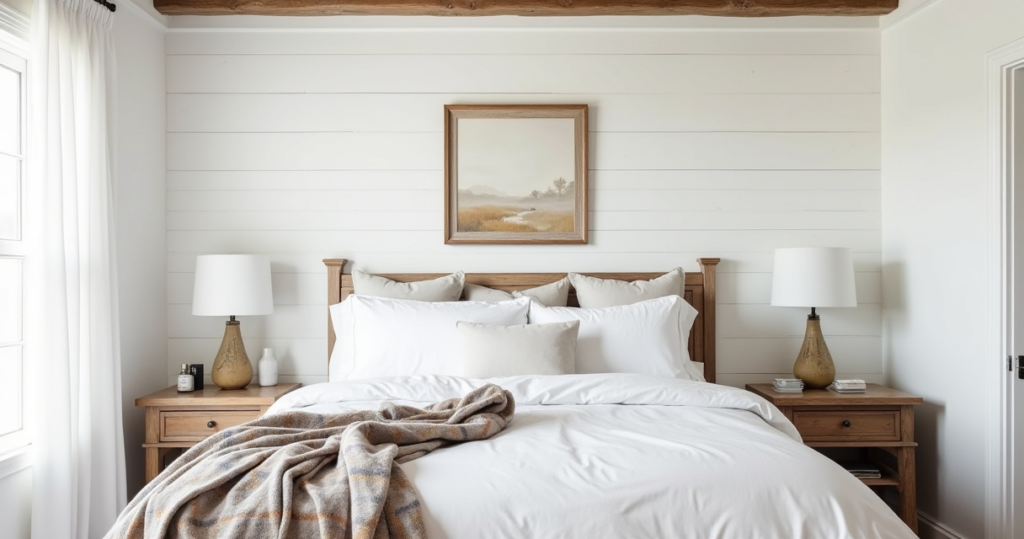Picture this: You’re standing in a small workshop just outside Jaipur. The air smells of sawdust and chai. An artisan’s hands, stained with dye and history, move with a quiet rhythm, carving a story into a piece of reclaimed mango wood. In the years I’ve spent connecting with these master craftspeople, I’ve learned that the true soul of rustic design—that deep, cozy feeling we all crave—isn’t about buying a specific “look” from a catalog. It’s not about barn doors and shiplap, not really. It’s about the hours of artistry and the human touch embedded in an object. It’s about the story the wood tells, the weaver’s intention in a throw, the beautiful imperfection that says, “I was made by hand, with heart.”
So when you ask me about rustic decor, I’m not just going to give you a shopping list. I’m going to share the real story behind creating a space that feels like a warm, loving embrace. We’re going to talk about what actually matters—texture, story, and soul—and what’s just noise. Forget the corporate speak. This is how you weave that rich, authentic, and deeply personal magic into your own bedroom sanctuary.
Laying the Rustic Foundation: Essential Planning & Structural Elements (Part 1)
Before you buy a single pillow, we need to talk about the bones of the room. A strong foundation is what makes everything else sing. It’s like the perfectly prepared canvas for a masterpiece. Think of this stage as setting the mood—it’s where we decide the rhythm and the heartbeat of your space.
1. Define Your Story, Not Just a Style
Everyone will tell you to pick a “sub-style”—farmhouse, industrial, cabin. Honestly? I find that so limiting. It’s like being told you can only cook with three spices. Can we talk about why that’s the wrong way to start? Instead of boxing yourself in, ask yourself: What story do I want this room to tell? Do you dream of a serene, minimalist retreat like a Keralan backwater cottage, with light woods and woven cane? Or maybe the rich, layered history of a Rajasthani haveli, with darker woods and touches of aged brass?
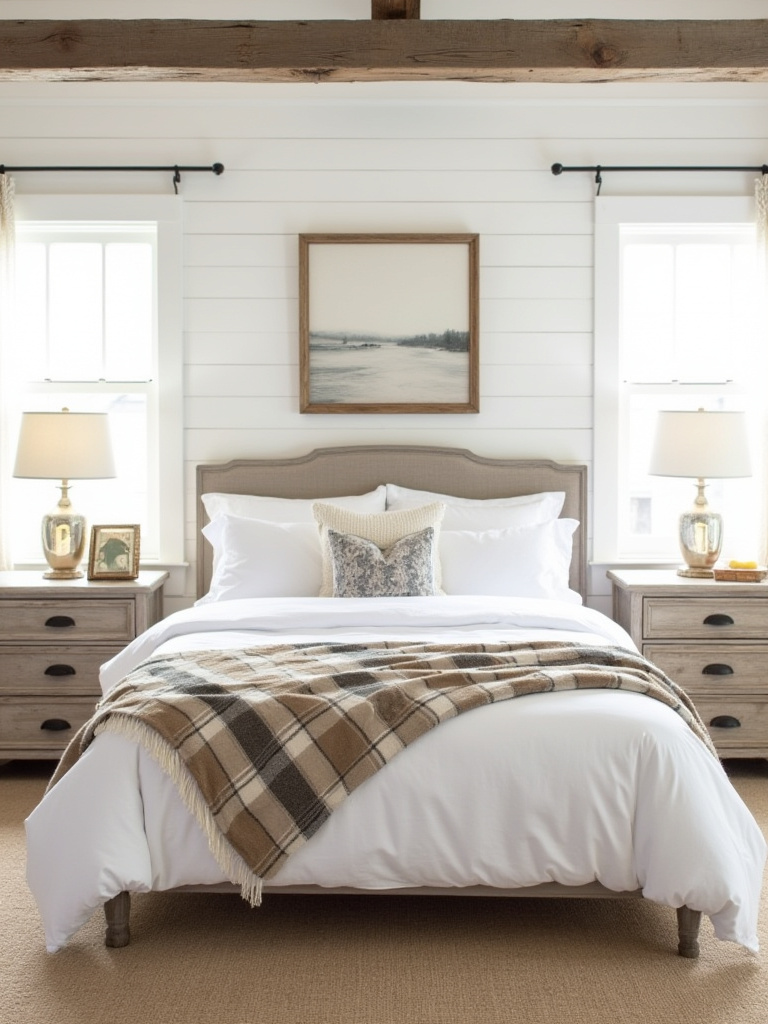
Thinking in terms of a story gives you a beautiful filter for all your choices. It’s your guiding star. Forget Pinterest categories for a second and create a mood board based on a feeling. Is it “Monsoon afternoon reading nook“? “Himalayan sunrise”? When you start with a feeling, every choice—from the paint color to a doorknob—becomes intuitive and cohesive. You’re no longer just decorating; you’re building a world.
2. Celebrate the Bones with Exposed and Reclaimed Wood
If you’re lucky enough to have exposed wood beams, you’ve been given a gift! So many people paint over them, trying to make everything look smooth and modern. But those beams are the soul of the room. Sand them, oil them, let their grain and history show. It’s the architectural equivalent of embracing your laugh lines—they show a life well-lived.
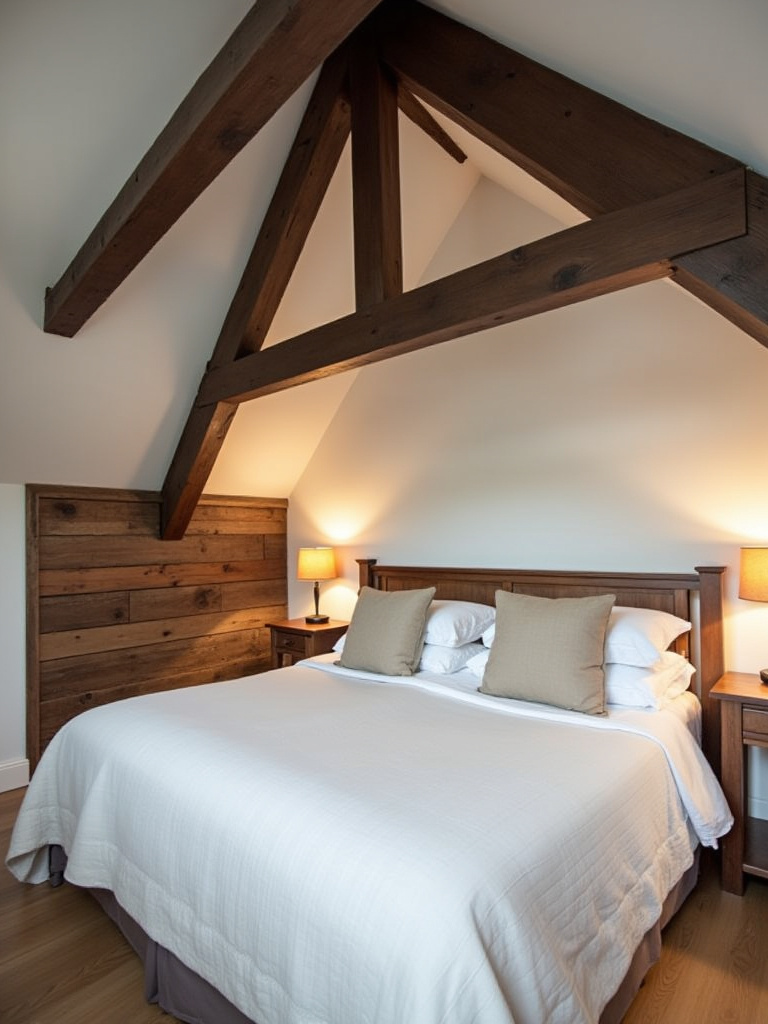
If you don’t have them, you can absolutely bring them in. Adding a reclaimed wood mantelpiece or a feature wall paneled with old wood is magic. I once worked on a very modern apartment and we clad one wall behind the bed with wood from an old Gujarat door. Instantly, the sterile white box had a heartbeat. It’s about adding history where there is none. Just make sure the wood has been treated properly—you want its story, not its splinters or pests.
3. Build Your Palette from the Earth
Forget sterile greys and harsh whites. A rustic room needs a color palette that feels like it was dug from the earth. Think of the warm, muted tones of spices: creamy turmeric, soft terracotta, dusty cinnamon, and the gentle off-white of unbleached cotton. This warm, neutral base is the quiet stage that lets all your beautiful textures shine. It’s a calming embrace.
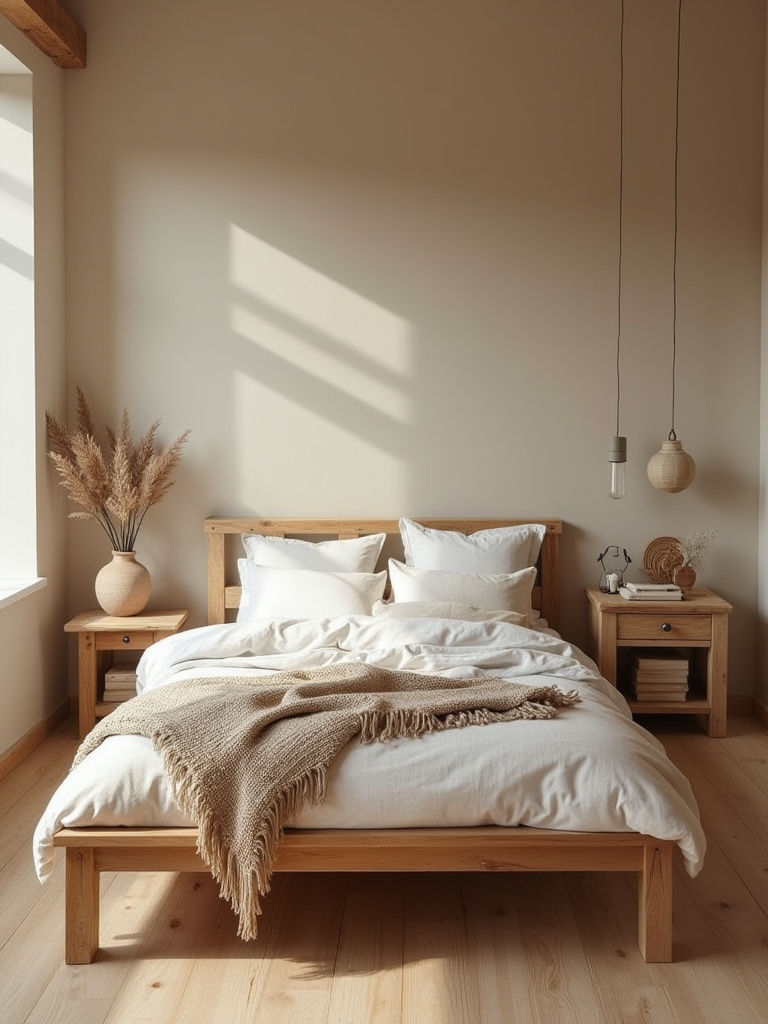
The biggest mistake people make is thinking rustic has to be dark and brown. Not at all! A light, airy room can be incredibly rustic if the textures are right. Start with a beautiful warm neutral for your walls—something like a creamy beige or a soft taupe. Then, layer in your wood tones and textiles. This allows you to bring in pops of richer, earthier color through your accents without the room feeling chaotic.
4. Work with Your Room’s Unique Character
Before you add anything new, take a long, hard look at what’s already there. Does your room have a charming arched window? An old brick fireplace? Don’t fight these features—make them the hero! Instead of hiding an old radiator, paint it a beautiful matte black or bronze and make it a feature. Instead of squaring off an arched doorway, emphasize it.
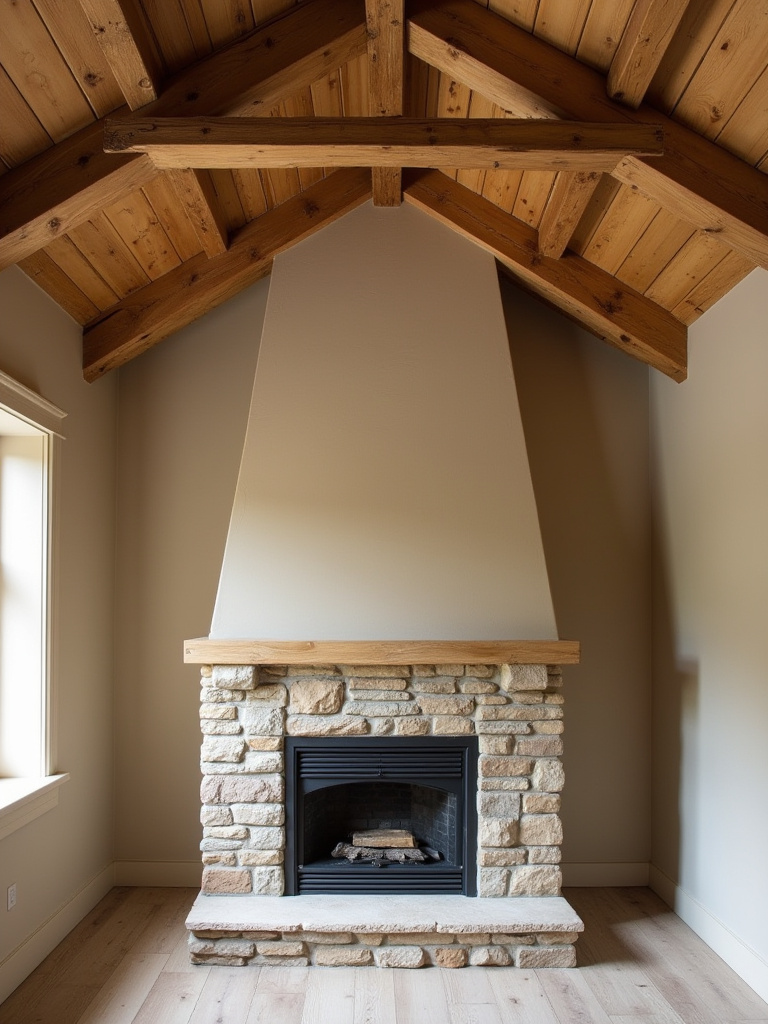
I learned this the hard way when I first tried to impose a sleek, modern look on an old home. It felt… wrong. Like it was wearing a costume. The real magic happened when I leaned into its quirks. By highlighting the original character of a room, you’re honoring its history and creating something truly authentic. This is the ultimate shortcut—you’re collaborating with your home instead of fighting against it.
Laying the Rustic Foundation: Essential Planning & Structural Elements (Part 2)
Now that we’ve set the stage, let’s get our hands on the most fundamental elements. The ground beneath our feet and the way we move through the space are next, because true comfort is about more than just what you see—it’s about how the room holds you.
5. Start from the Ground Up with Natural Flooring
What’s under your feet sets the tone for everything. Wall-to-wall carpet might feel soft, but it kills a rustic vibe. You need something that feels solid and real. Hardwood is the obvious, beautiful choice. Wide planks with a bit of texture or a matte finish are perfect. They feel incredible underfoot and only get better with age, as they gather the scuffs and marks of life.
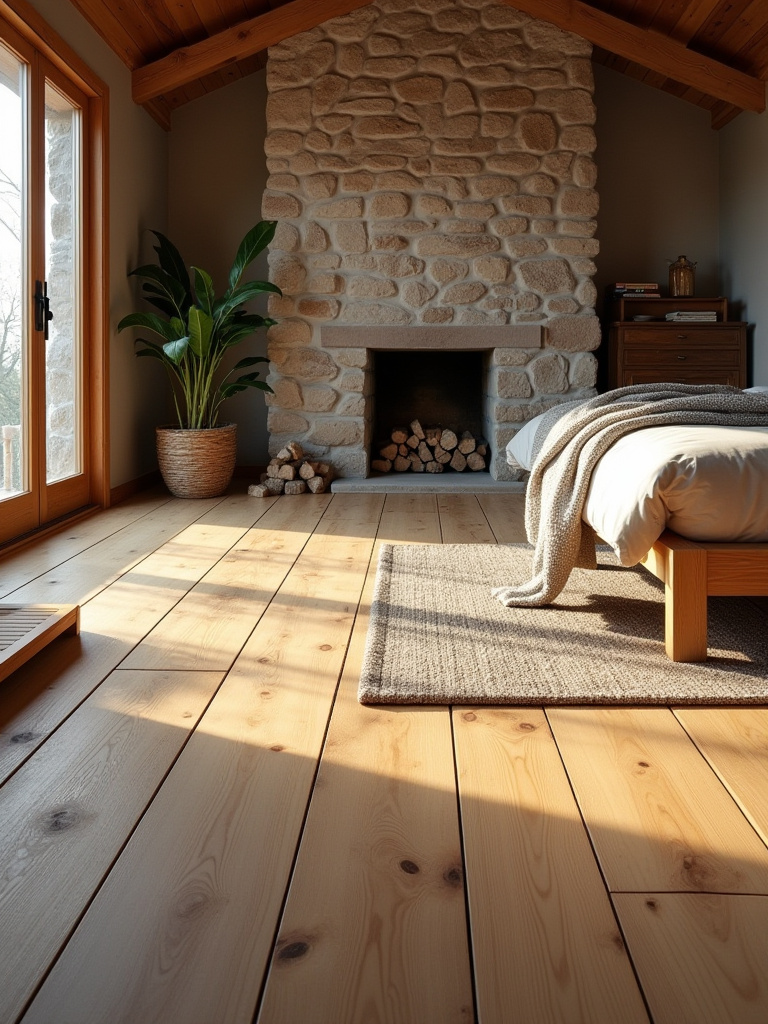
But don’t forget stone! In India, we have a long tradition of using beautiful, cool stone floors—from golden Jaisalmer sandstone to polished Kadappa slate. In a warmer climate, a natural stone floor is a dream. It feels grounding and ancient. The key is to choose a material that has natural variation and texture. It’s noise when you see flooring that is perfectly uniform; the real story is in the imperfections.
6. Design for Living, Not Just for Looks
You know what people always ask me? “How do I make my room look beautiful and livable?” The answer is the layout. A room that looks gorgeous but is awkward to move around in is a failed design. Period. Before you place a single piece of furniture, think about flow. Where do you walk? Where does the morning light hit? Where would you naturally want to sit with a cup of tea?
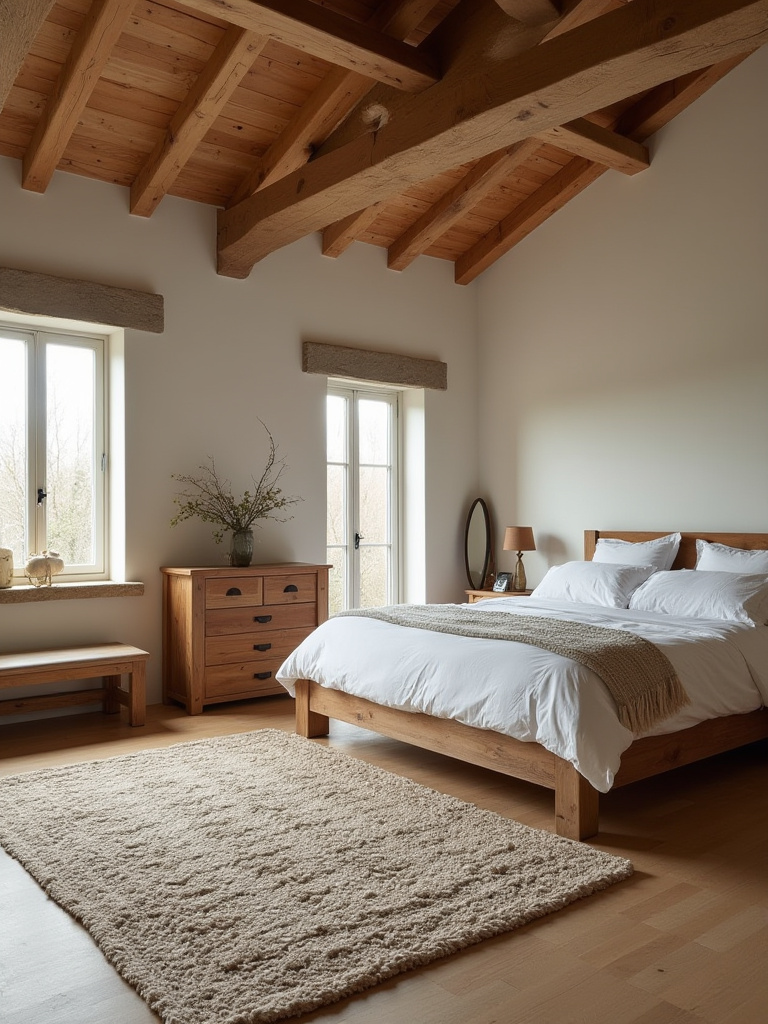
Don’t just shove the bed against the biggest wall. Consider placing it where it has a view of the door but isn’t directly in line with it—a principle from Vastu Shastra that promotes a sense of security and peace. Make sure you have clear pathways. A rustic bedroom should feel like a sanctuary, not an obstacle course. Use painter’s tape on the floor to map out furniture before you commit. It will save you a world of backaches and frustration.
Cultivating Core Rustic Charm: Furniture & Natural Materials (Part 1)
With the bones of our room feeling solid and harmonious, it’s time to bring in the key players. Furniture is where the personality really starts to emerge. This is where we choose the pieces that will hold our clothes, our dreams, and become part of our daily lives.
7. Make the Bed the Heart of the Room
Your bed isn’t just a place to sleep; it’s the anchor of the entire room. In a rustic bedroom, this piece has to be wood. A sturdy, solid wood bed frame says “stability,” “comfort,” and “permanence.” Forget the flimsy metal frames or overly ornate upholstered headboards. We want something with presence.
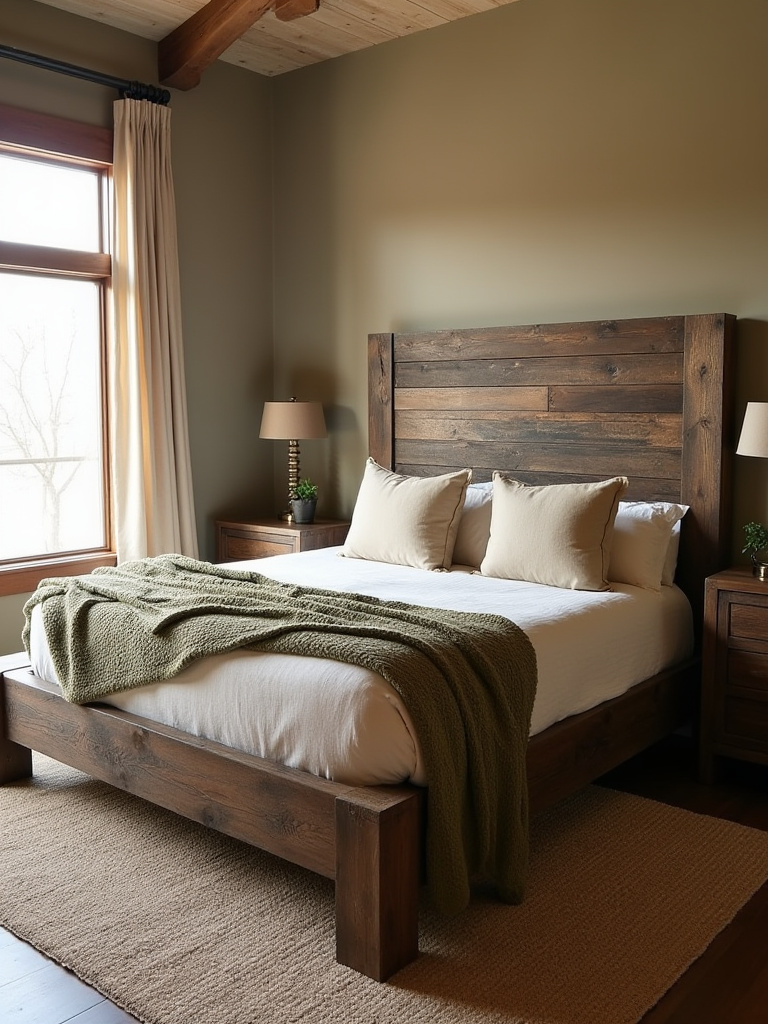
Look for a bed made from a beautiful wood like Sheesham, Mango, or reclaimed Teak. The beauty of these woods is their rich grain and durability. A friend of mine has a bed made from an old Rajasthani four-poster frame—it’s the most magnificent, soulful piece of furniture and it tells an incredible story. Even a simple platform bed in a rich, warm wood can ground the whole space. Let this be your one big investment piece.
8. Choose Furniture with a Past
Everyone says to buy distressed furniture, but here’s what they get wrong: so much of it is fake. You can see the factory sanding marks, the perfectly uniform “wear.” It feels soulless. The real magic is in pieces that have an actual history. A reclaimed wood dresser, a nightstand made from an old shipping crate, a chest that has lived a hundred lives.
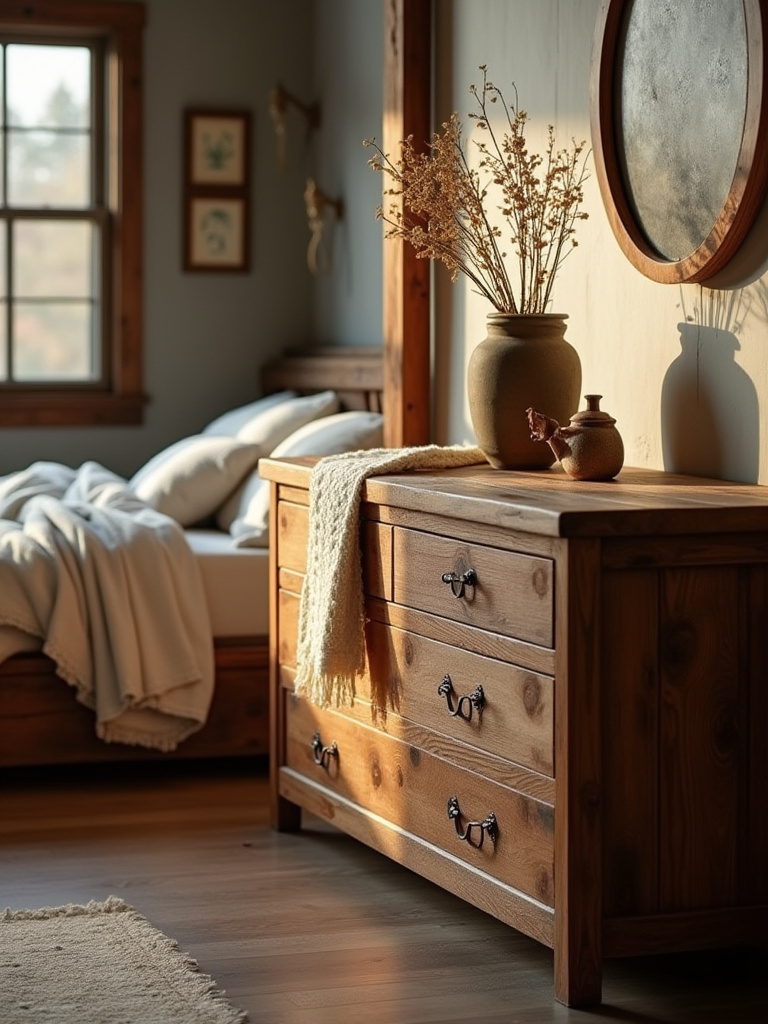
I wish someone had told me earlier to skip the big box stores and head straight for the flea markets, antique shops, and architectural salvage yards. That’s where you find the treasures. Look for pieces with good bones—solid wood, dovetail joints. A little scratch or water ring isn’t damage; it’s patina. It’s character. These are the pieces that bring a deep, resonant warmth to a room that you simply cannot buy new.
9. Add the Strength of Wrought Iron
Rustic charm isn’t all soft and woodsy. It needs a little bit of strength, a touch of grit to balance the softness. That’s where iron comes in. But I’m not talking about shiny, modern metal. I’m talking about hand-forged, matte black wrought iron. It has a weight and a texture that feels timeless.
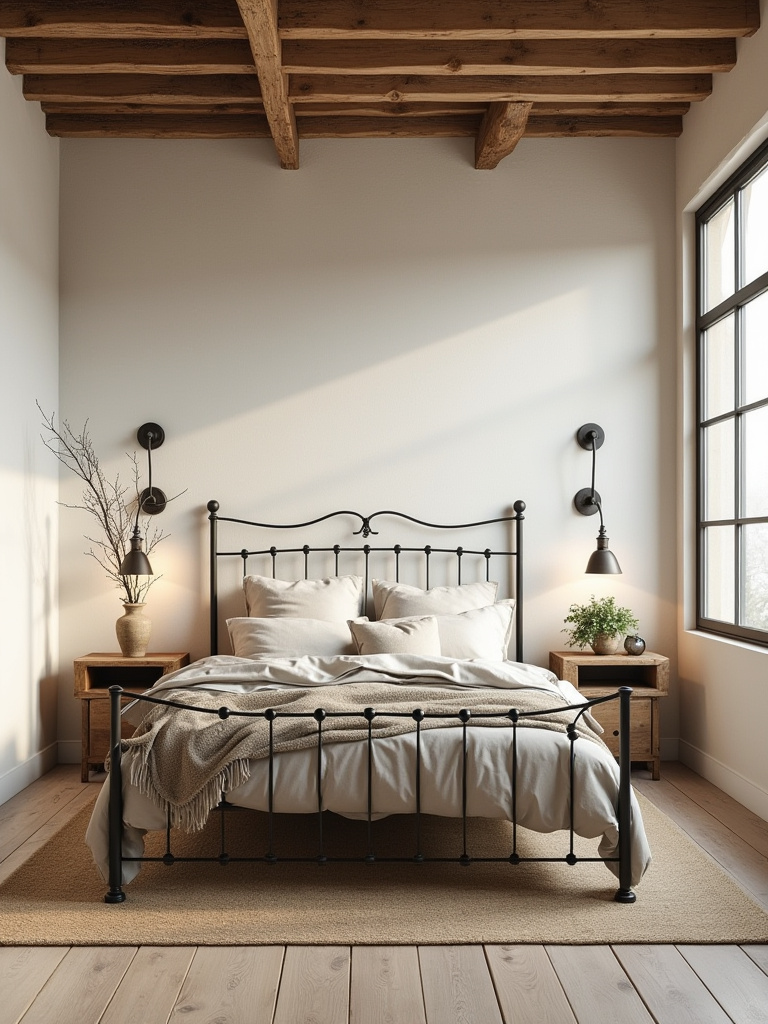
Instead of just curtain rods, think about using it in more interesting ways. In India, we have a beautiful tradition of jaali—intricately carved screens. A wrought-iron jaali screen used as a headboard or a room divider is breathtaking. It adds pattern and texture while still feeling strong and rustic. Even small touches like iron drawer pulls or simple, forged shelving brackets can provide that perfect, grounding contrast.
10. Ground the Space with Natural Stone
When you think of stone in a bedroom, you might immediately think of a grand fireplace. And yes, a rugged stone fireplace is the ultimate rustic dream! But there are smaller, more accessible ways to bring in this beautiful, earthy element.
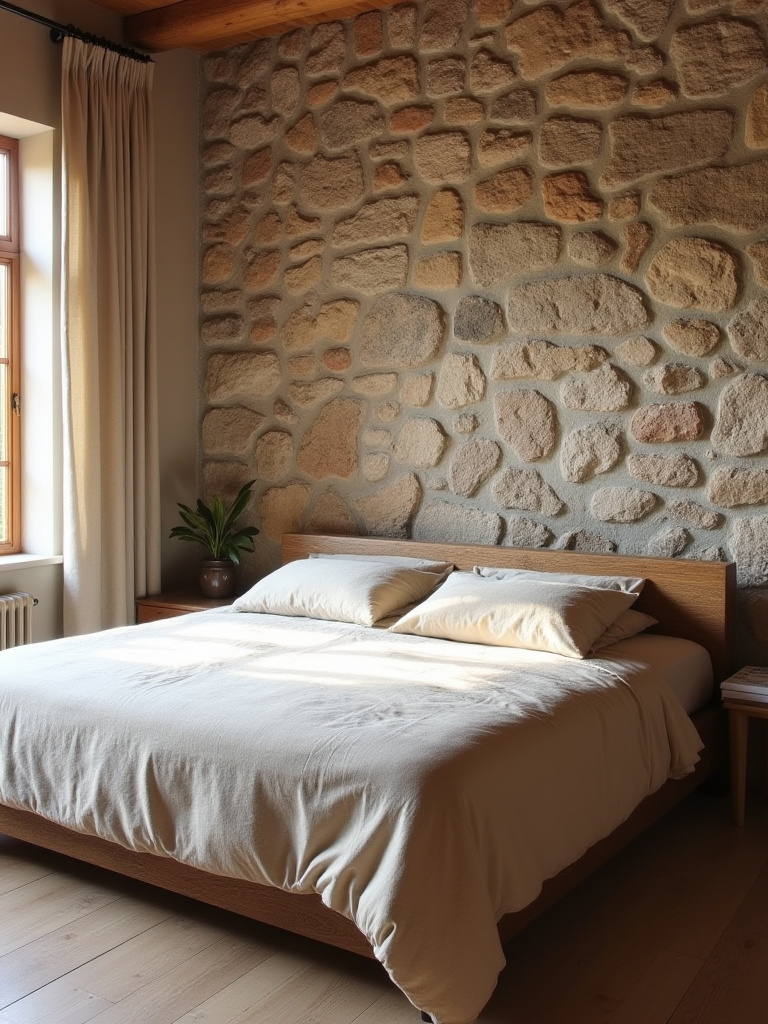
Think about a stone accent wall behind the bed using thin ledger stone. Or use a beautiful piece of carved sandstone as a piece of wall art. I once found a collection of old marble temple fragments and mounted them on a client’s wall; they brought an instant sense of sacredness and history to the space. Even something as simple as using slate tiles for a hearth or a heavy stone base for a lamp adds a crucial, grounding element that connects your room back to the earth.
Cultivating Core Rustic Charm: Furniture & Natural Materials (Part 2)
We’ve built the foundation and brought in the main characters. Now it’s time for the details that make these core pieces truly shine. These next touches are about celebrating the raw, untamed beauty of natural materials in their purest forms.
11. Embrace the Perfectly Imperfect Beauty of Live Edge Wood
Can we talk about how everyone gets live edge wrong? They seal it in a thick, glossy layer of plastic-like epoxy until it loses all its natural character. The whole point of live edge wood is to celebrate the tree it came from! It’s about honoring the natural, flowing line where the bark used to be. The surface should be silky smooth, yes, but it should feel like wood, not plastic.
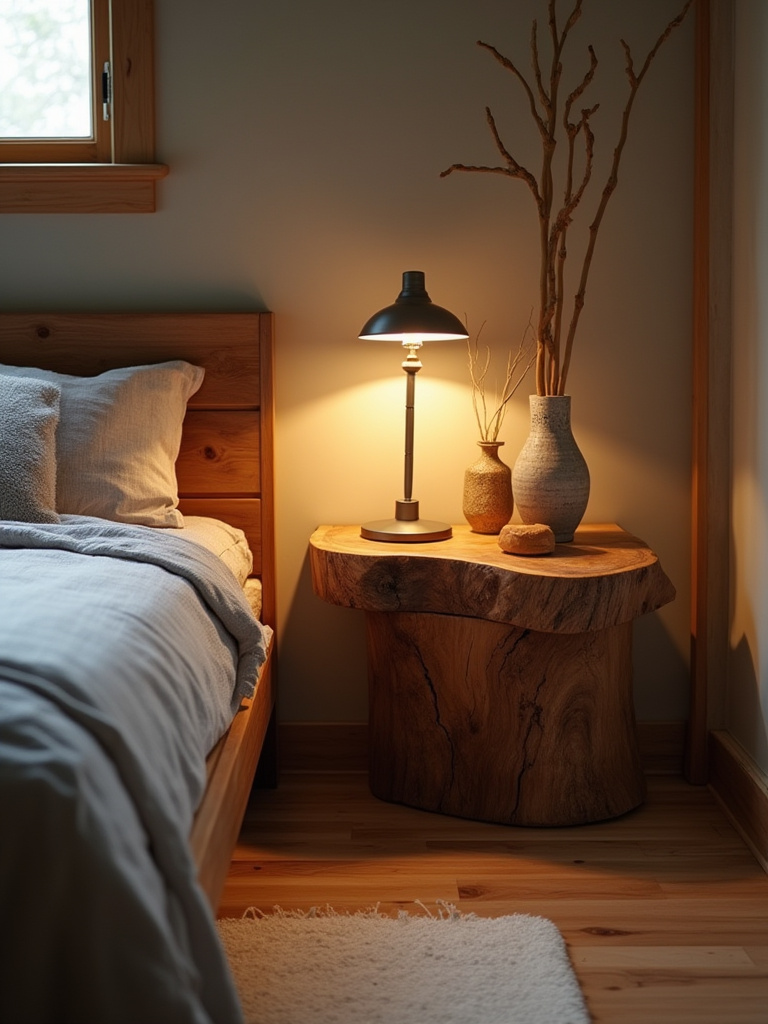
A live edge shelf, a small side table, or even a headboard is a piece of sculpture. It’s a statement that says you find beauty in nature’s imperfections. I always recommend finishing live edge pieces with a natural oil or wax. It brings out the depth of the grain and protects the wood while letting you feel its actual texture. It’s the difference between looking at a picture of a forest and actually walking through it.
12. Use Woven Baskets for Texture and Tidiness
A rustic bedroom should feel serene, and you can’t have serenity with clutter. Woven baskets are the secret weapon here. They are the perfect marriage of form and function. They hide all the messy stuff—laundry, extra blankets, magazines—while adding a huge dose of beautiful, natural texture.
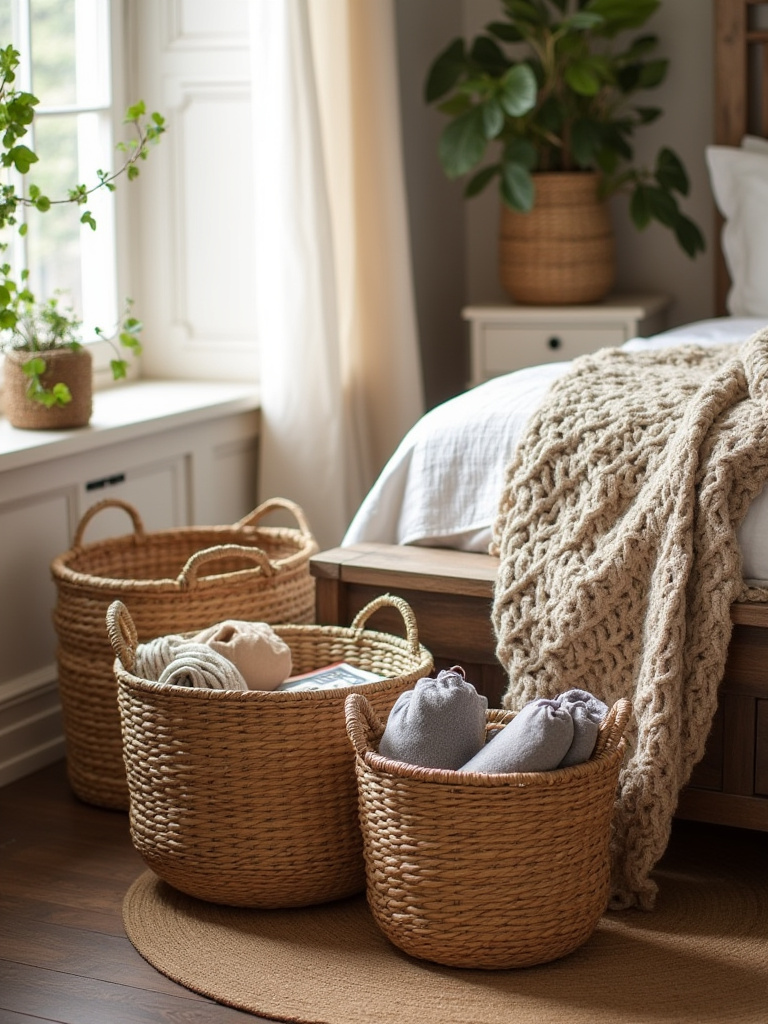
And there are so many incredible traditions of basketry to explore! Look for baskets made from seagrass, water hyacinth, or Sabai grass. The different weaves and natural tones add so much visual interest. I use them everywhere. A large one in the corner for throws, a set of three on a shelf for smaller items, a flat one on the wall as art. They are an affordable, beautiful way to add an authentic, handcrafted layer to your room while keeping it blissfully organized.
Enriching Rustic Aesthetics: Textures, Fabrics & Artistic Touches (Part 1)
Alright, we have the structure and the main furniture in place. The room has good bones. Now, for my favorite part—the layers that bring the soul. This is where we add the softness, the art, and the sensory details that make a room truly feel like a hug.
13. Layer Textiles Like a Pro
A confession: I used to think more was always more with textiles. Then I created a room that looked like a fabric store exploded. The secret isn’t just piling on layers; it’s about a conversation between textures. You need a mix of rough and smooth, thick and thin. Start with a base of breathable, natural linen for your duvet. Linen has a gorgeous, slightly crumpled texture that is the definition of relaxed rustic.
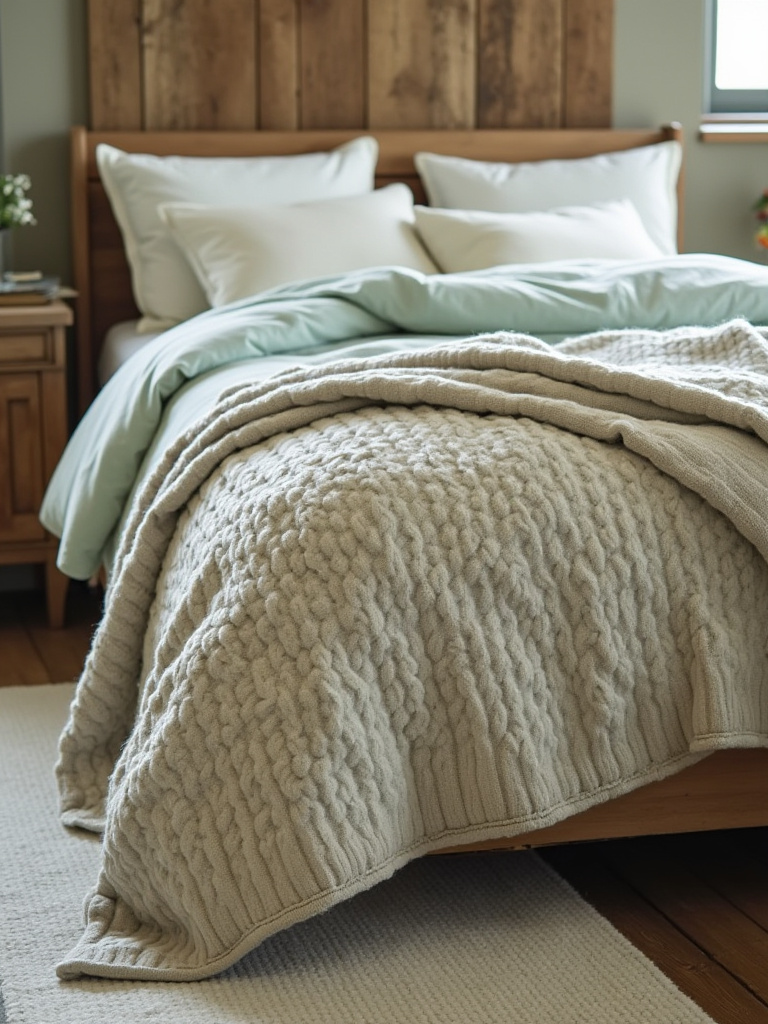
Then, add a story. Instead of a generic throw, find a handmade Kantha quilt. Each one is stitched by hand from old saris by women in Bengal, and they carry so much history and soul. Add a chunky wool knit for pure cozy indulgence, and maybe a pillow made from nubby, raw silk. Don’t be afraid to mix patterns, especially the subtle, imperfect patterns of block prints. This thoughtful layering is what creates that deep, inviting, “I never want to leave this bed” feeling.
14. Frame Your Views with Natural Curtains
Heavy, formal drapes have no place in a rustic bedroom. We want to celebrate natural light, not block it out. The answer is lightweight curtains made from natural fibers like cotton, linen, or a cotton-silk blend. They soften the edges of the window and filter the light into a beautiful, ethereal glow.
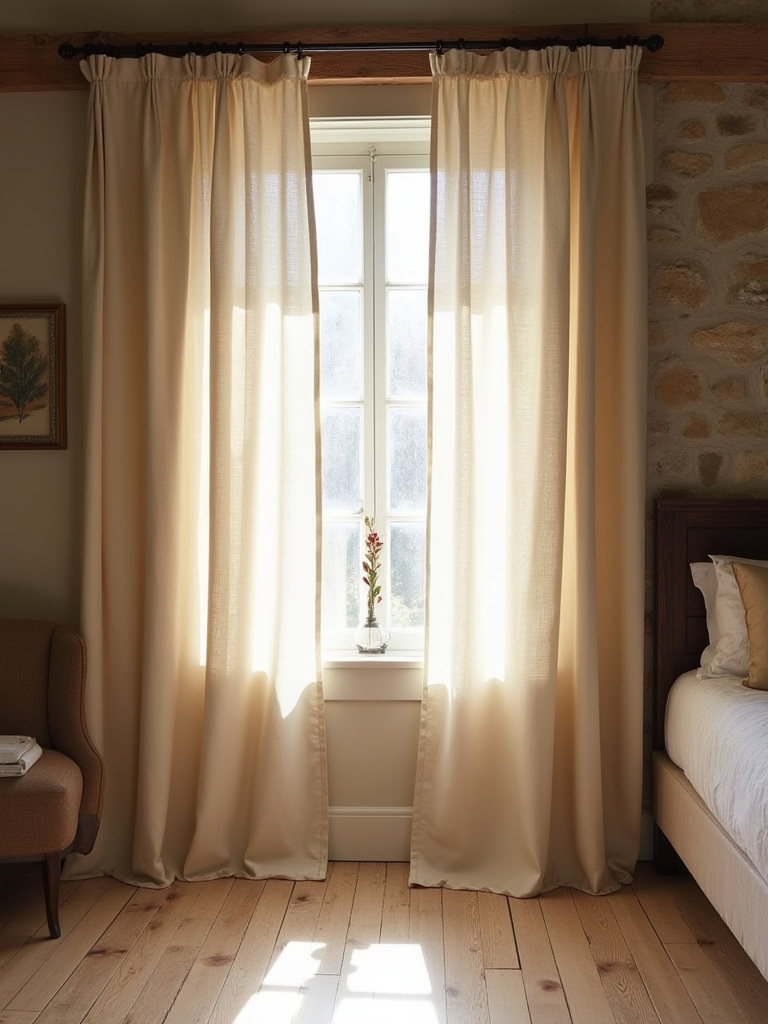
For a touch of artistry, look for curtains with a delicate, hand-stamped block print. The slight variations in the pattern are a beautiful reminder of the human hand that made them. I always suggest hanging your curtains high and wide—mounting the rod several inches above the window frame and extending it beyond the edges. This simple trick makes your windows look bigger and the whole room feel more grand and airy.
15. Add the Human Touch with Handcrafted Pottery
Nothing adds an immediate touch of artisan soul like a piece of handcrafted pottery. Factory-made vases are perfect; handcrafted ones are alive. You can feel the maker’s hands in the slight asymmetry, the texture of the glaze. It’s that perfect imperfection we’re chasing.
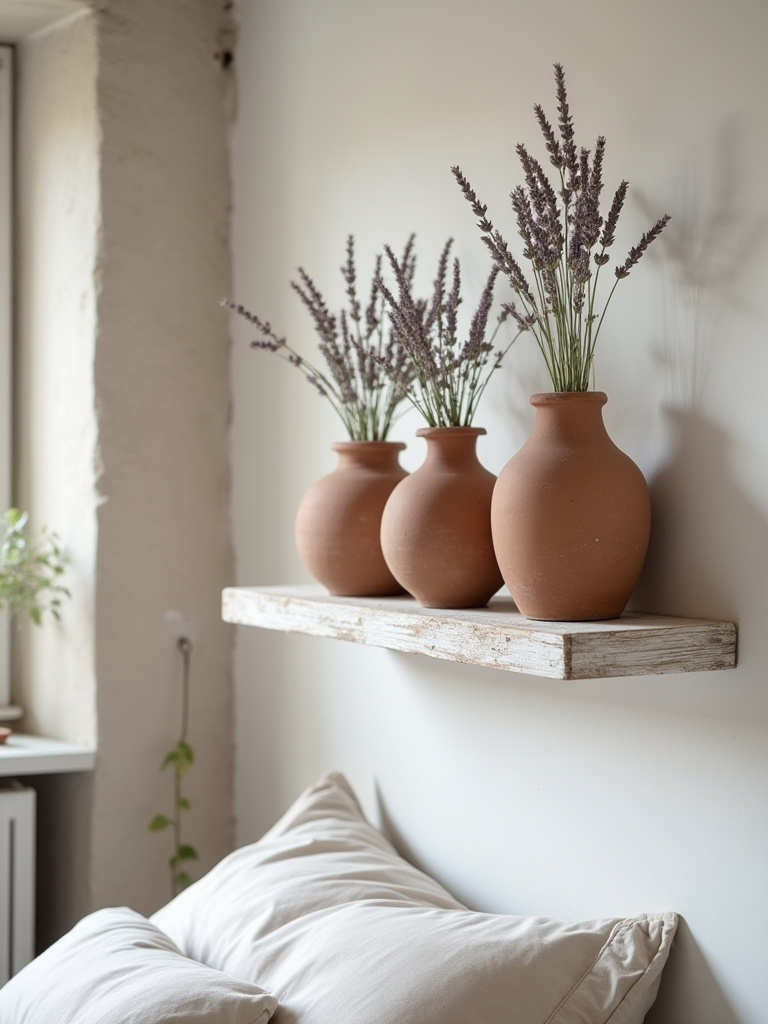
Start a small collection. A simple terracotta vase holding a few stems of dried eucalyptus, a Jaipur blue pottery dish for your keys, a rustic unglazed pot on your bookshelf. Group them in threes, playing with different heights and shapes. These aren’t just objects; they are small sculptures that ground your space and connect you to a long tradition of artistry.
16. Tell a Story with Your Wall Art
Please, step away from the mass-produced “Live, Laugh, Love” signs. Your walls are an opportunity to tell your story. Art in a rustic room should feel personal and grounded. Think about serene landscape paintings, detailed botanical prints, or something with more cultural depth.
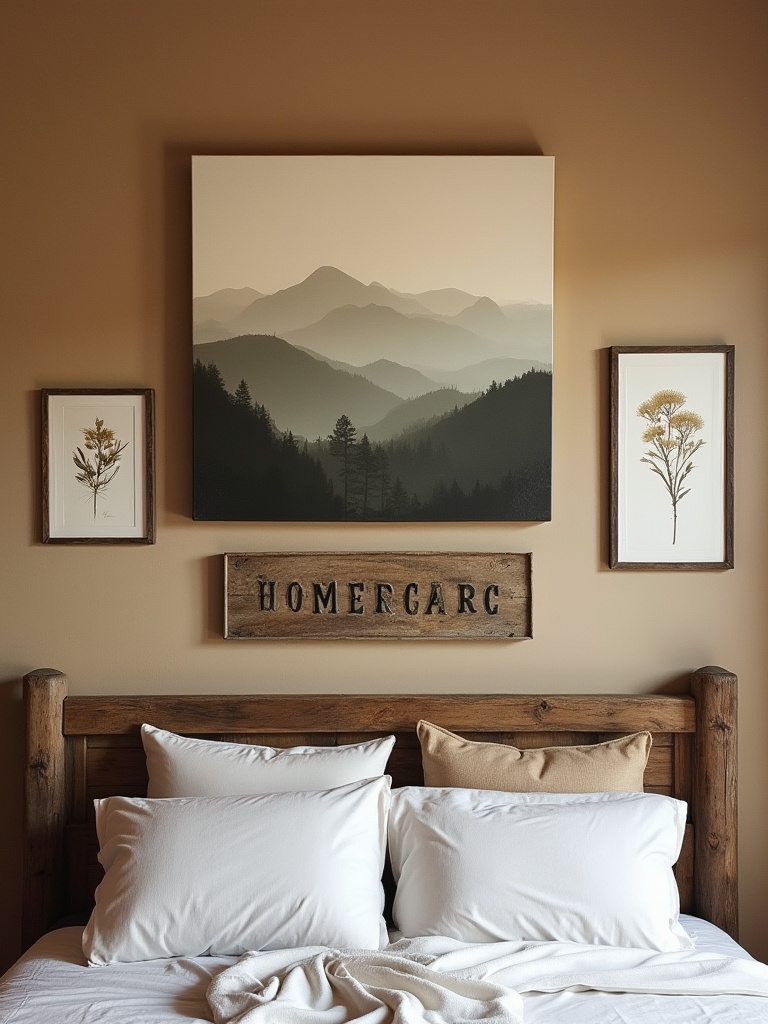
I absolutely adore using traditional art forms like Warli paintings from Maharashtra, with their simple, beautiful depictions of village life, or a grand Pichwai painting of cows and lotuses as a major statement piece. Another beautiful idea is to frame a piece of vintage textile, like a gorgeous old sari border or a piece of phulkari embroidery. This not only adds color and pattern but also honors incredible craftsmanship. It turns your wall into a gallery of stories, not just decorations.
Enriching Rustic Aesthetics: Textures, Fabrics & Artistic Touches (Part 2)
The room is really starting to come together now, isn’t it? It’s filled with beautiful textures and stories. Now let’s add those final, crucial layers of comfort and luxury that truly elevate the space into a restorative haven.
17. Introduce the Timeless Appeal of Leather
A touch of leather adds a rich, sophisticated warmth that beautifully complements the rawness of wood and stone. A worn leather armchair in a corner, a simple leather bench at the foot of the bed, or even just a few leather-bound books on a shelf can add an instant sense of history and gravitas. The beauty of leather is in how it ages, developing a unique patina over time that tells its own story.
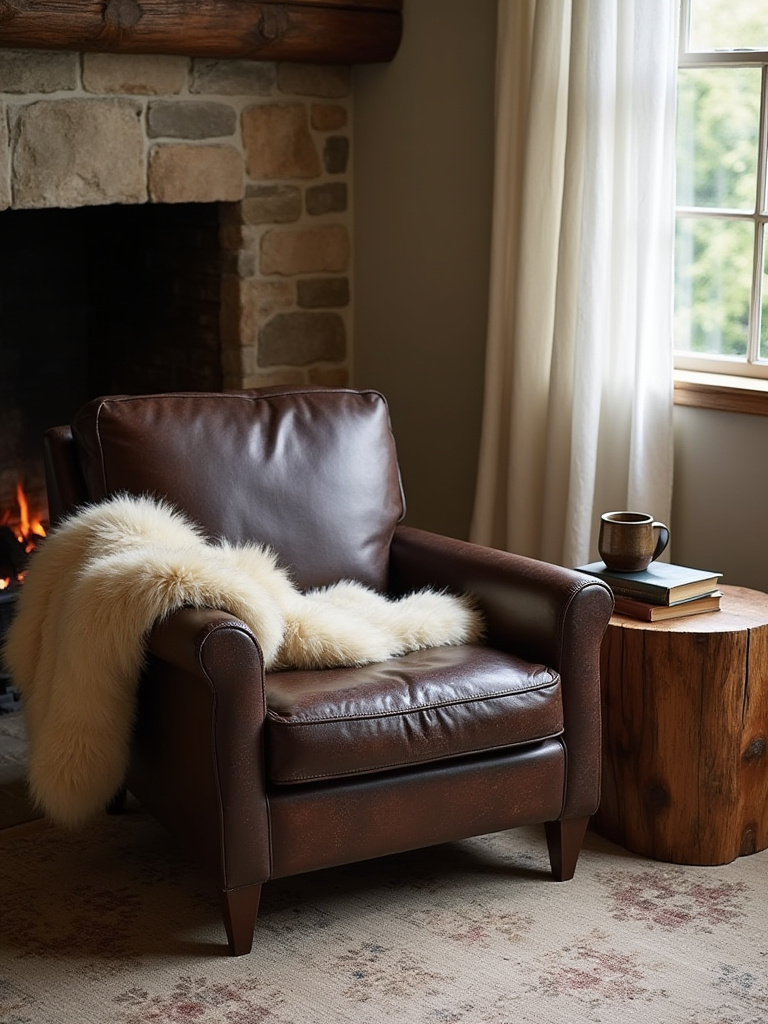
Don’t feel like it has to be a huge investment. High-quality faux leather can work beautifully, especially for smaller items like a desk chair or an ottoman. Just look for pieces with a matte finish and a bit of texture to them. The key is to balance the sturdiness of the leather with softer textiles—drape a soft woven throw over that armchair to create an irresistible invitation to sit down and relax.
18. Indulge in Luxurious, Cozy Textures
This is your sanctuary. It should feel ridiculously comfortable. Faux fur or sheepskin are the ultimate shortcut to instant, unapologetic coziness. A sheepskin throw draped over a chair or a faux fur rug next to the bed is pure sensory delight. It’s that final layer of softness that makes a room feel truly indulgent and nurturing.
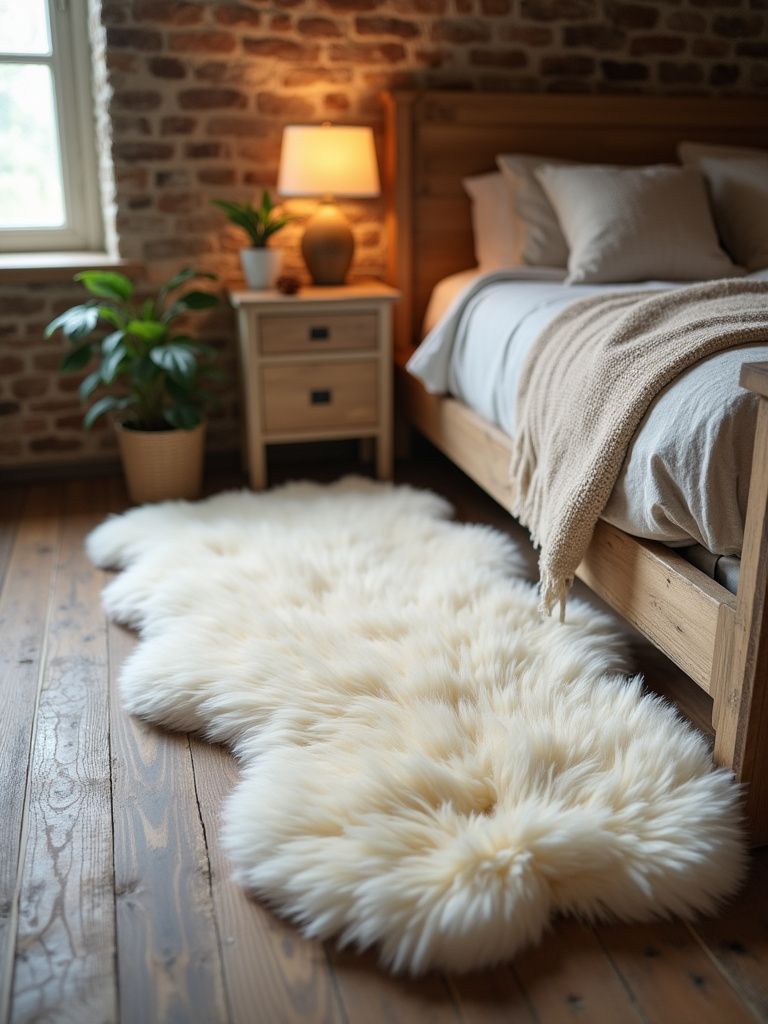
I love using these textures to soften harder elements. A sheepskin rug on a stone floor, for example, is a beautiful contrast of hard and soft, cool and warm. It’s about balance. This isn’t just about looks; it’s about how the room feels on your skin. When you step out of bed in the morning, sinking your feet into something so plush and warm is a small act of self-care that sets the tone for the entire day.
Completing the Rustic Haven: Lighting, Accents & Personalized Flair (Part 1)
We’re in the home stretch! The room looks and feels incredible. These final touches are the sparkle, the personality, the details that make this room uniquely and unmistakably yours.
19. Cast a Warm Glow with the Right Lighting
Lighting is everything. You can have the most beautiful room in the world, but if it’s lit by a single, harsh overhead light, it will feel like a waiting room. The goal is warm, layered, ambient light. Edison bulbs with their warm, visible filaments are perfect for this, as they mimic the gentle glow of candlelight.
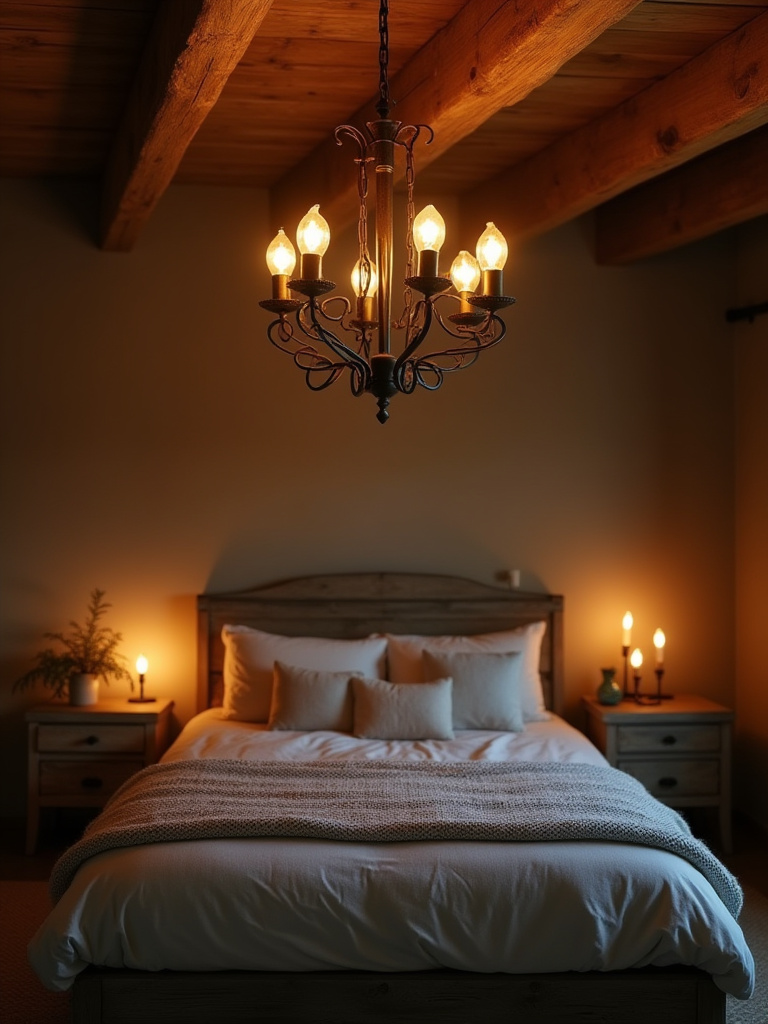
Incorporate fixtures that have rustic character. A simple chandelier made of wrought iron, sconces with wood details, or even lamps made from brass or copper will cast a beautiful, warm light. Put everything on a dimmer switch. This is non-negotiable! It’s the single most important thing you can do to control the mood of your room, allowing you to go from bright and functional to soft and intimate with the turn of a dial.
20. Breathe Life into the Room with Greenery
Every room needs something that’s alive. Plants are the easiest way to bring life, color, and organic texture into your space. They purify the air and have a proven calming effect. They soften the hard lines of furniture and connect your indoor sanctuary with the natural world outside.
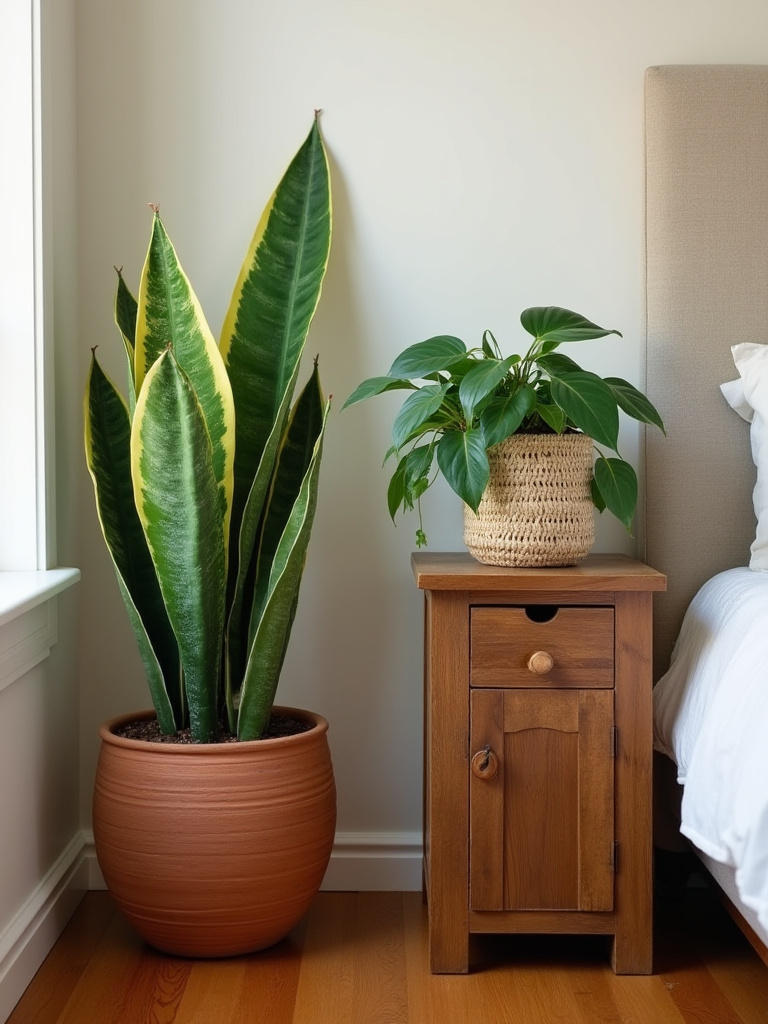
You don’t need to create an indoor jungle. A simple snake plant in a terracotta pot, a trailing pothos on a high shelf, or a vase of fresh eucalyptus on the dresser is enough. In India, many homes have a Tulsi (Holy Basil) plant in a special pot for its auspicious properties. The point is to bring in that vibrant, living energy. If you’re not confident with plants, dried arrangements of pampas grass, cotton stems, or lavender offer a beautiful, maintenance-free alternative.
21. Curate a Collection of Vintage Treasures
This is where the true soul of your room lives. Vintage finds carry an energy and a history that new items just don’t have. Curate a small collection of objects that speak to you. It’s not about clutter; it’s about thoughtful storytelling.
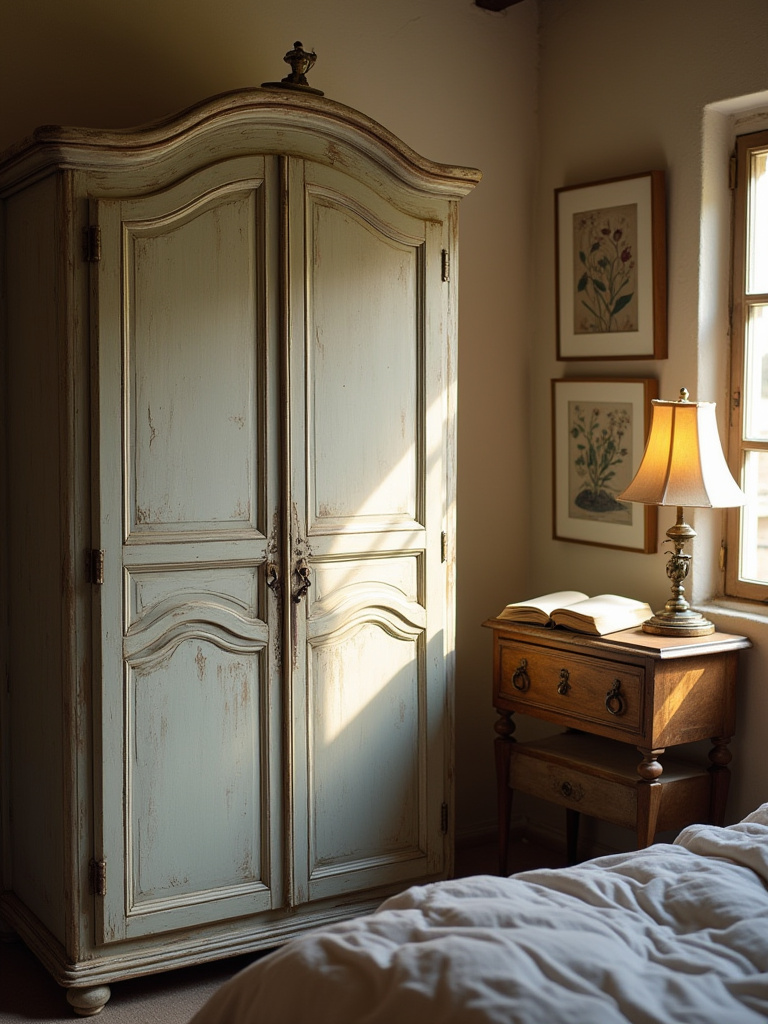
An old brass vessel, a set of antique wooden printing blocks, a vintage dowry chest (a sandook) used for storing blankets—these pieces bring so much character. Scour flea markets and antique shops. Look for things that show their age, that have a bit of tarnish or a worn spot. These are the details that keep your eye moving around the room, discovering little stories in every corner.
22. Know When to Stop
Here’s a hard truth: rustic can quickly turn into cluttered. The most common mistake I see is people filling every single surface. You need to let your beautiful pieces breathe. Negative space—the empty space on a wall or a surface—is just as important as the objects themselves. It gives your eyes a place to rest and allows you to appreciate the items you’ve so carefully chosen.
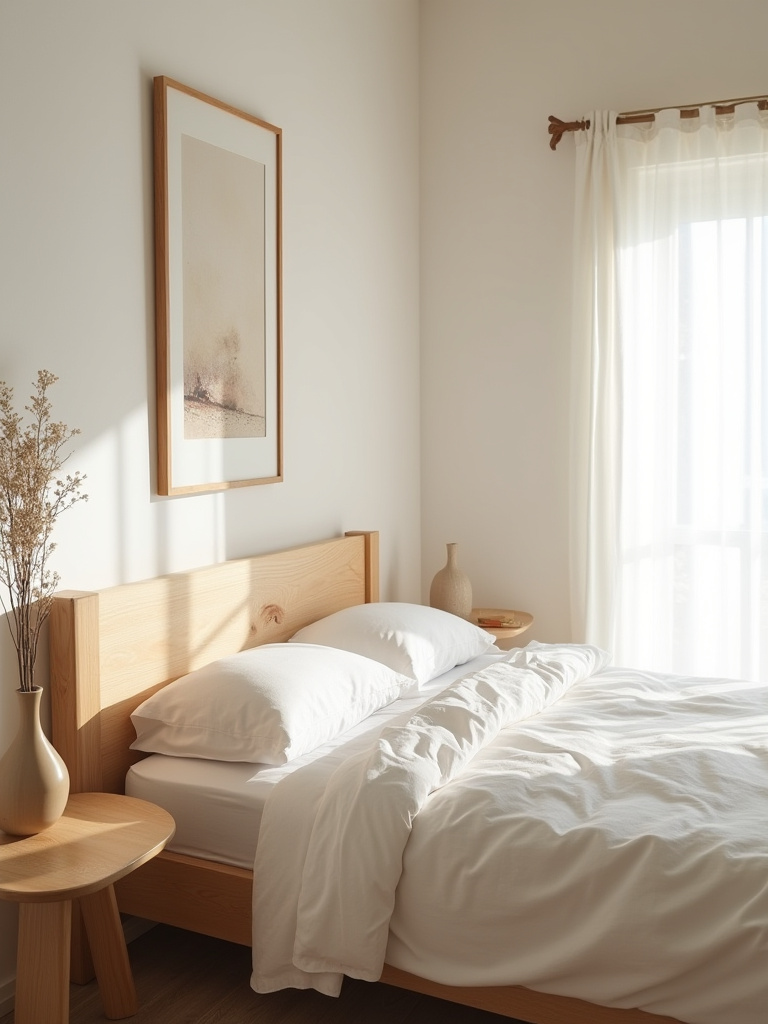
Before you add one more thing, step back and ask, “Does this room feel calm?” The goal is a serene sanctuary, not a rustic-themed gift shop. A good rule is “one in, one out.” If you bring a new treasure home, find something else to store or pass along. Curating your space is an ongoing process of editing, and sometimes, the most powerful design move is taking something away.
Completing the Rustic Haven: Lighting, Accents & Personalized Flair (Part 2)
One last, final touch. This is the one that weaves your own spirit into the very fabric of the room.
23. Weave Your Own Life into the Decor
Your bedroom should be the most personal space in your home. It should be a reflection of you, your loves, your travels, your history. A rustic room provides the perfect, warm backdrop for your own story. Frame photos of people you love in simple, mismatched wooden or silver frames. Display a beautiful shell you found on a beach trip, a small piece of pottery you bought on vacation, a drawing from your child.
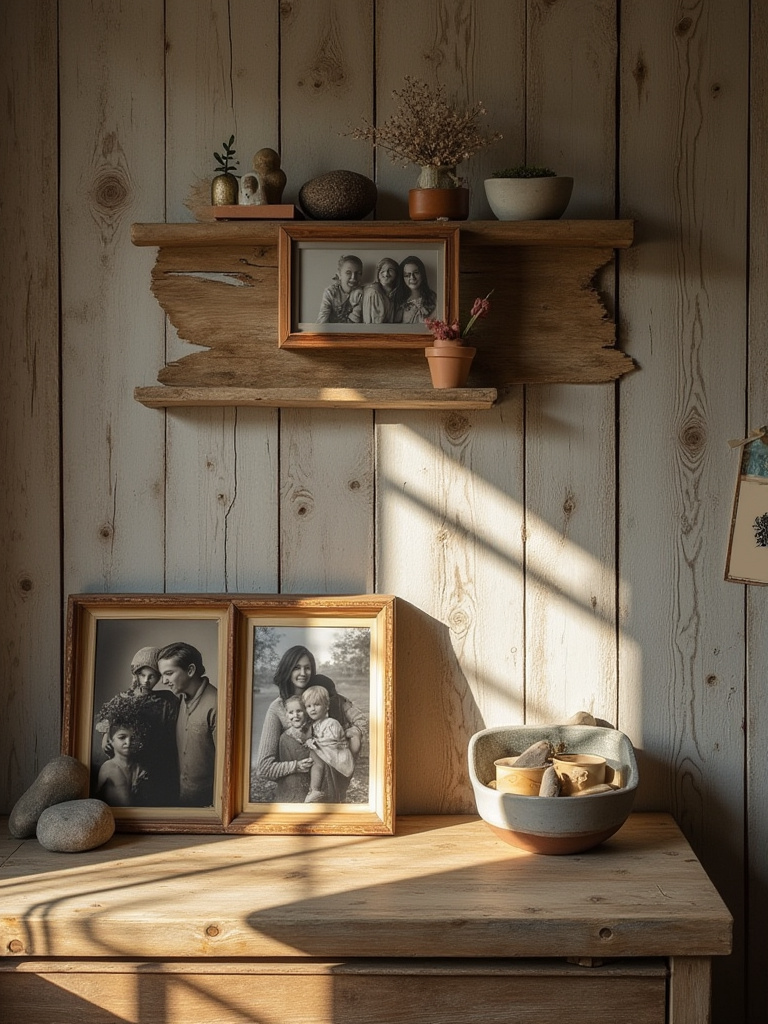
Don’t hide these things away. These are the elements that make a house a home. They are the irreplaceable, one-of-a-kind decorations that no one else can have. Arrange them in small vignettes on your shelves or nightstand. This isn’t about creating a perfect, magazine-ready room. It’s about creating a room that holds you, that reminds you of who you are and what you cherish. That is the true heart of a rustic haven.
Conclusion
So there you have it. Creating a rustic haven is so much more than following a trend. It’s a return to what’s real: natural materials, handcrafted quality, and personal stories. It’s about building a room that not only looks beautiful but feels deeply calming and authentic—a space that tells the story of the hands that made its contents, and more importantly, the story of the person who lives there.
Don’t feel like you need to do everything at once. True warmth is cultivated over time. Start with one thing that spoke to you—perhaps it’s finding a beautiful Kantha throw, or starting a collection of handmade pottery. Let your space evolve with you. The journey of creating this sanctuary is just as beautiful as the destination. So go on, start weaving your own story into the walls of your home. Create a space that doesn’t just shelter you, but truly restores you, day after day.
